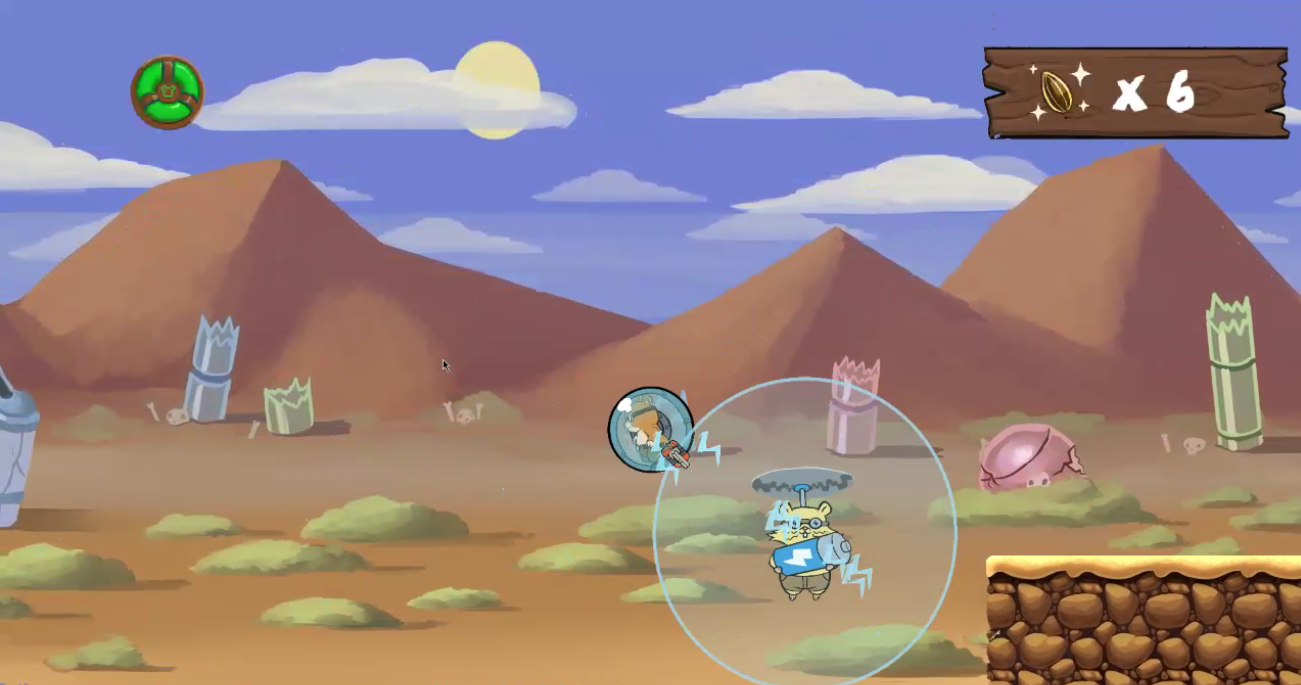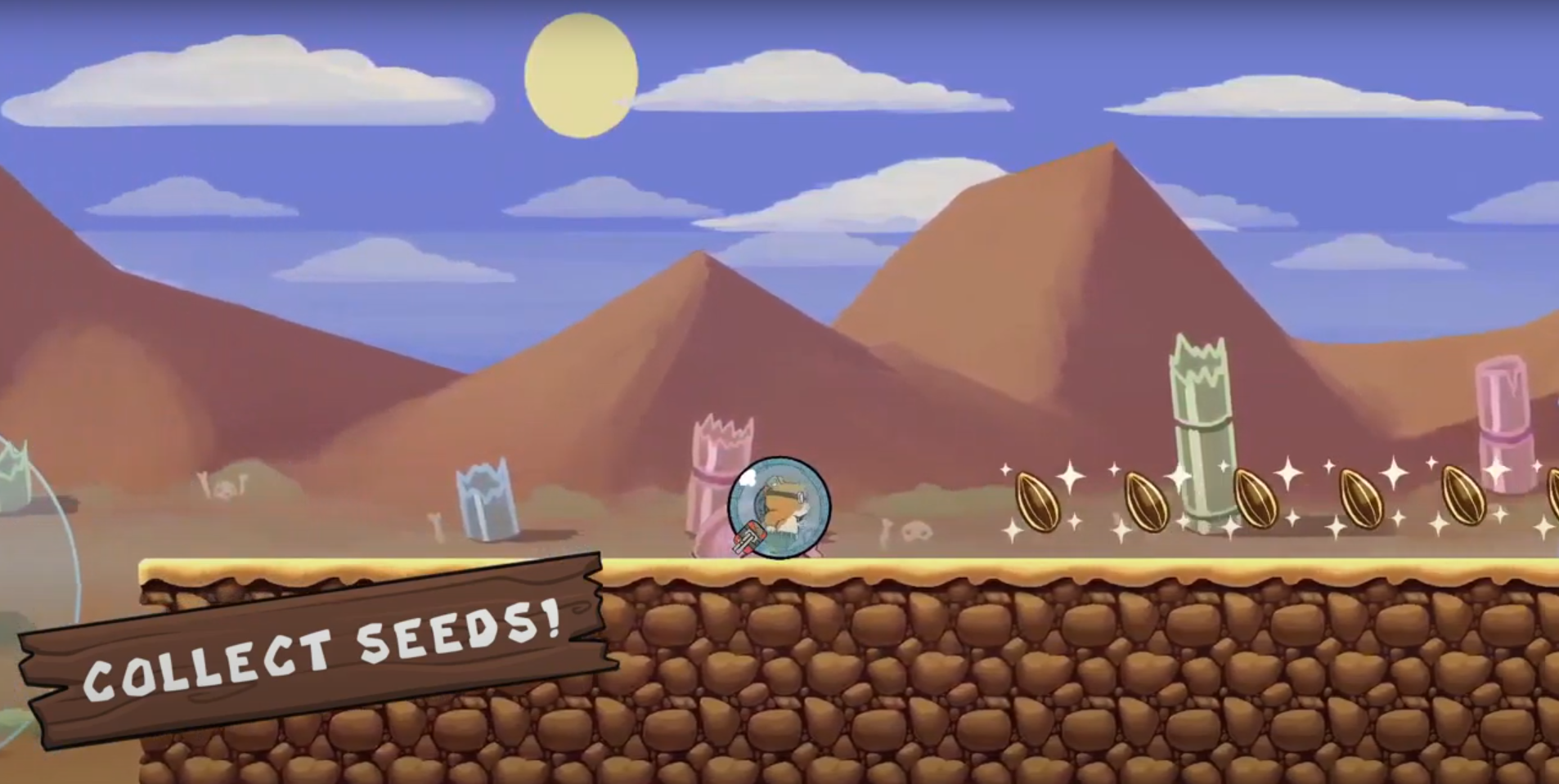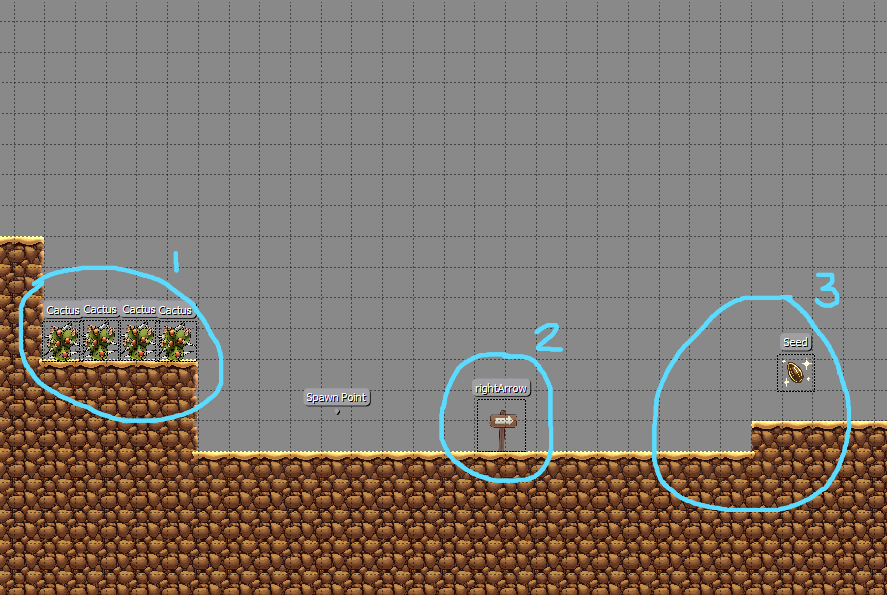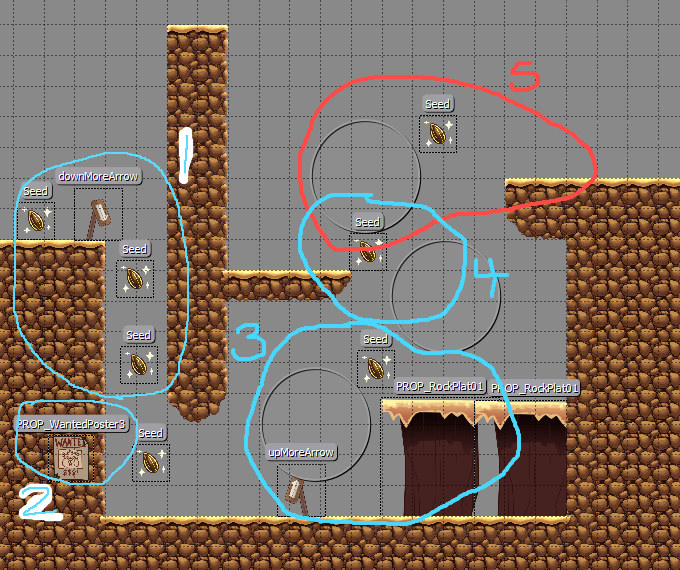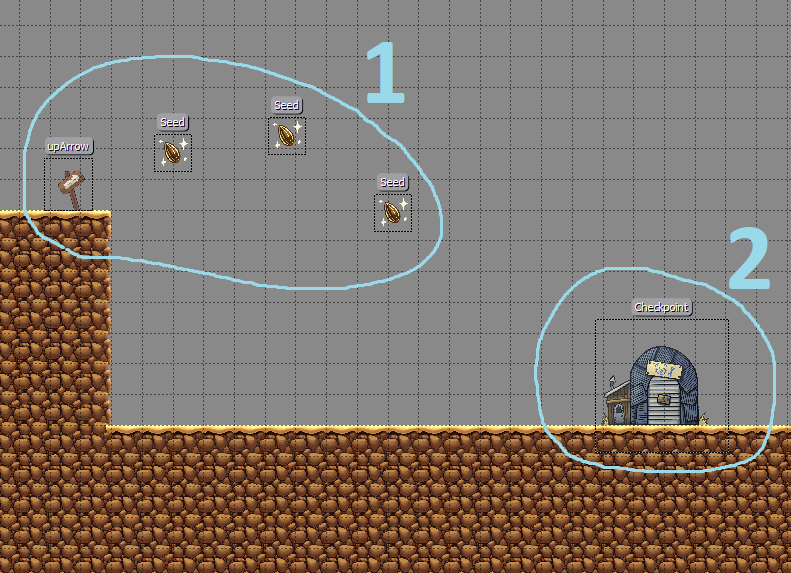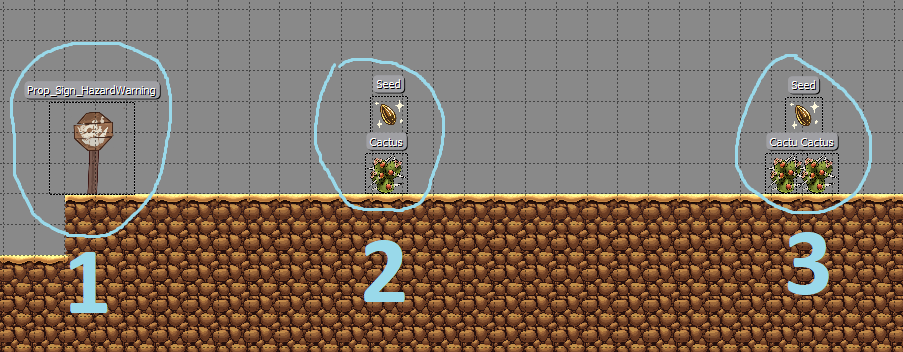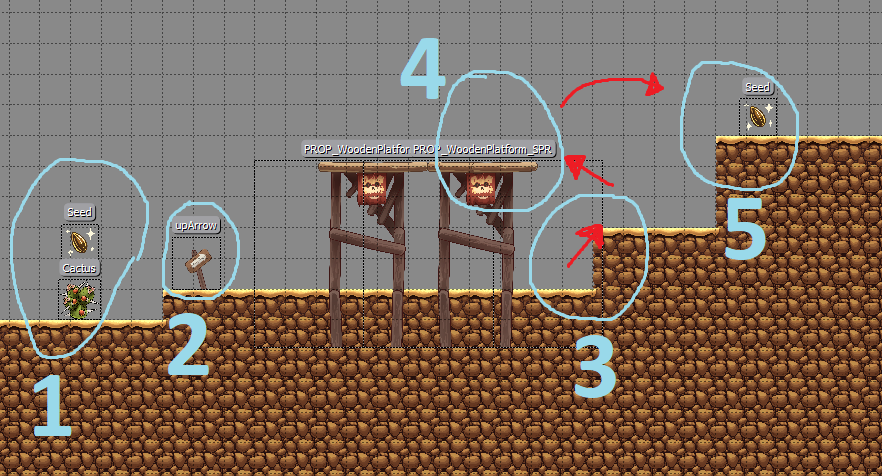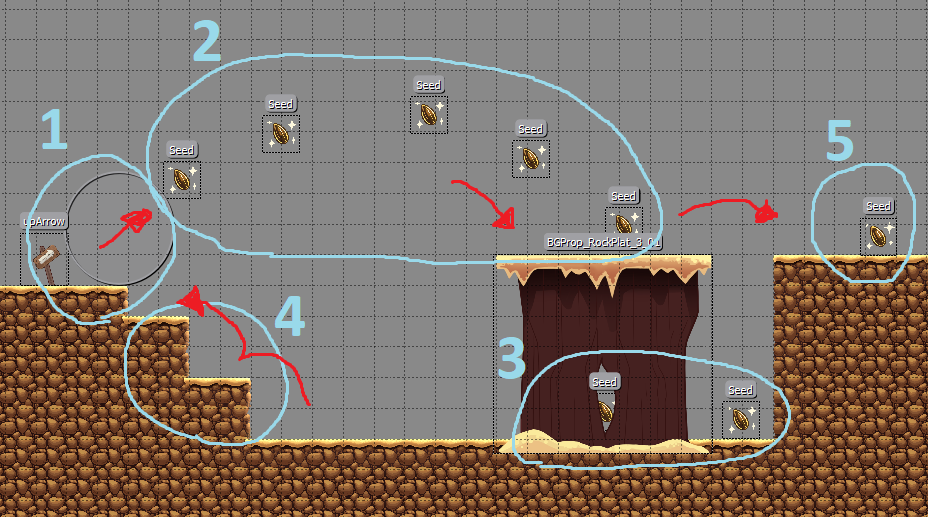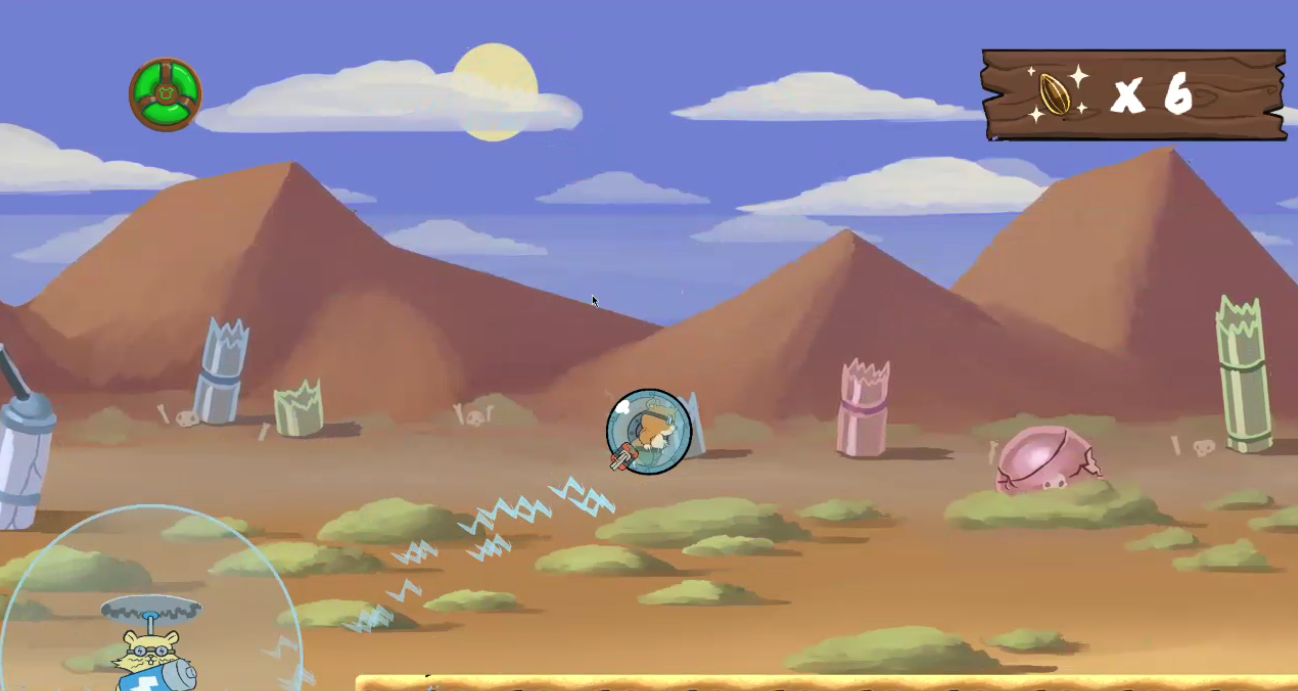
Hamster Havoc
2020-2021 Academic Team Project
-
This is the first spawn point of the entire game. Immediately visible to the player are the cactuses (1) on a cliff, a tile too high for the player to reach. This introduction to the cactuses allows the player to safely view the cactuses, without being able to touch them, and become hurt. It also gives the level a bit of visible difference. In playtesting when players reached the end of the level and the second level was loaded in (which in early engine versions did not have a smooth fade in and out, but rather a quick snap) The player immediately assumed that the level had restarted and that they were at the beginning of the first level again, rather than at the beginning of the second level. To counteract the confusion I added visually distinct elements to the starting frames of every level, which stayed even as the transitions became more understandable and smooth.
Immediately ahead of the player, and also in the starting frame, is the first arrow sign that points directly right (2), which is also the main direction that the player will be heading in for the duration of the game.
The first challenge the player runs into (3) is a tutorialization that requires the player to jump to pass. To jump in Hamster Havoc the player must press space which is a common jumping key and has posed no challenge to any players. Often players first go towards the cacti(1), which are out of reach, and try to jump up to the cacti, upon learning they can't, they go in the direction of the arrow (2) and simply pass the first jumping challenge (3).
-
This is the first tutorialization area of the game. Using simple challenges which slowly increase in difficulty and introduce new concepts in simple terms we teach the player the main mechanic of the game. First is a small jump, only 1 tile high. Second is a slightly taller jump two tiles high, to make sure the player knows how to jump, and is able to jump to a point at their maximum jump height. Third is the first introduction of a dash zone, the player must use the dash zone to jump to a point that is one tile higher than their maximum jump height. Originally I only had the third example to teach the dash zone mechanic, however through testing players often got onto that cliff by accident while spamming keys. To reinforce the dash zone tutorial I included the fourth zone which has a drop. This drop requires the player to go to the dash zone from the side and time out when they press the space a second time while in the dash zone. The fourth zone discourages key spamming and requires the player to learn the dash zones' complete mechanics. Thus in four simple areas, the player has learned how to play Hamster Havoc.
-
The above image is a challenge zone that ensures the player’s ability to use dash zones and introduces some key concepts. First is a downward blind fall or a pit, not all pits are good in Hamster havoc, some lead the player to an instant death floor that respawns them. The signifiers are used to show the player that this is not an instant death pit, first is the wall to the right of the pit that blocks any other path forward, second is the down arrow, and third is the trail of seeds leading down the pit.
When the player reaches the bottom of the pit they get to see some new environmental storytelling, a wanted poster with a picture of the playable character. Although the in-game story has not been fleshed out the poster adds to the sense of lawlessness and builds a world outside of the paths the player is on. In the third element, the player must use the dash to reach a platform that is 4 tiles up, the highest jump they’ve been given. The jump is relatively easy but requires the player to understand which directions they can propel themselves in. The jump also introduces a new platform type, which the player can go under, but has a collider on top. These platforms are used throughout the levels to break up the tiled platforms and give a sense of gravity, although not always possible. We tried to stay away from floating platforms in the level design. If we had more time we might have been able to create background walls that worked to make all the platforms look connected to the floor. The fourth example jump is the same height as the third example, but there is a gap in between where the two platforms end, which adds additional skill. The fifth example jump circled in red is not a height challenge but a length challenge, although it’s 3 tiles high it’s 5 tiles apart and requires the player to get a running start on the left platform.
-
First is a cliff, which acts as a fun reward for the player, giving them three seeds which they jump into, but also works as a cutoff. The level design of the game is meant to be fast and linear, and allowing the player to go back in order to redo areas or collect seeds they originally missed would work against the main mechanic and intention of the game's systems. Next is the checkpoint. I included a checkpoint here since the next mechanic introduced is the cacti. If the player accidentally hits the cacti more than three times the player dies, and I didn’t want to punish the player if they died while introduced to the cacti. Punishing the player by sending them to the beginning of the level is unnecessary since the first section of the level is a pseudo tutorial of mechanics that the player has already gotten used to, and presents no real challenge to a player who has reached the checkpoint. And forcing the player to redo the first section of the game after they just failed to jump over a cactus would create a frustrating sense of pacing.
-
Next, the level introduces cacti, first I included a hazard sign to warn the player against speeding ahead. Before this, the player has not encountered any hazards, and the main mechanics of the game encourages the player to rush forward. The hazard sign will hopefully warn the player to proceed cautiously as they are introduced to cacti, which require quick reactions. Second is the first cactus the player has been introduced to, not only has the cactus been made to look sharp with bits of red to show the danger, but also I included a seed above the cactus to make it clear to the player that they should jump over the cactus. Third is just two cactuses put together, also with a seed above, to increase the difficulty slightly.
-
The final two stages of the level contain skill testing. I used skill testing to both tests the player skill to see if they could progress through more difficult challenges and to give them a sense of the gameplay in future levels. The dual purpose of these challenges both tests the player's skill and entices them to continue playing. First in image 6 is a cacti, as introduced before, the cacti can harm the player and poses a simple obstacle. However, the cacti mainly works as a warning for the step up, two units past the cacti. The player's jump length goes way past two units, so when jumping over the cacti the player is also preemptively jumping onto the step up. Next is the up arrow in reference two in image 6, this foreshadows to the player that they will be heading up onto the platforms, but they’ll have to find a more complex path up. This is the first more vague signage, in past stages the sign points directly to where the player is heading, giving them less of a sense of direction and more a sense of safety. Now the signage is being used to point the player in the general direction they should be heading, this use of signage is more common as the game becomes more difficult. Using the path marked in red arrows the player must jump up to the platforms then cross the gap to reach the end of the challenge, marked conveniently by a seed to reassure the player that this is the right direction.
-
The final challenge in the level is a super jump challenge that the player must complete in order to reach the final area, this starts at 1, follows through 2, giving the player constant feedback that this is the correct path, and ends at 5, the final area which rewards the player and continues to the end of the game. If the player misses the jump there are no serious consequences, since this is still practice for future challenges. Instead, the player gets 2 bonus seeds and can only get out of the hole by going back to the super jump, figure 1, where they can try to get to the upper levels again.

Hamster Havoc Final Trailer
My Role: Level Designer, User Researcher, Design Lead
Eleven-Person group
Eight-month timeline (Two Semesters)
Academic Project
Designed all levels, tested and then iterated
Playtested systems, art, levels, UI
Helped Organize art and tech cooperation
Communicated design vision to art through visual presentations
